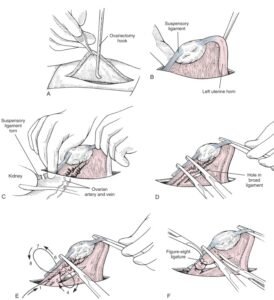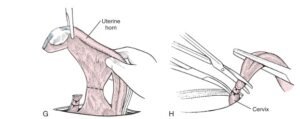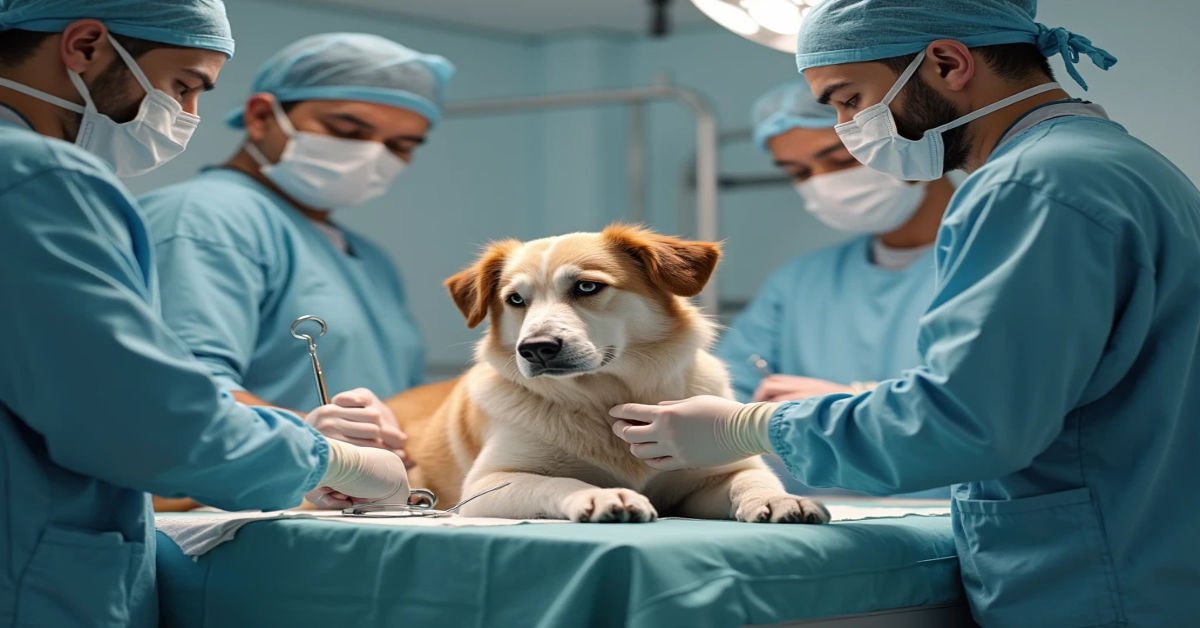Introduction
Spaying in bitch is also referred to as ovariohysterectomy (OHE) or ovariectomy (OVE), is a widely performed surgical procedure for female dogs. It is an effective solution to prevent estrus, unwanted pregnancies, and various health complications. This guide provides detailed insights into the indications, benefits, surgical methods, and frequently asked questions about spaying to help dog owners make well-informed decisions.
Why Should You Spay Your Dog?
Spaying offers numerous advantages beyond preventing unwanted litter. Here are the key benefits:
Health and Behavioral Benefits
- Reduced Risk of Mammary Tumors: Spaying before the first heat cycle lowers the risk of mammary tumors by up to 99%.
- Prevention of Pyometra: This life-threatening uterine infection is common in unspayed dogs.
- Elimination of Reproductive Disorders: Spaying prevents uterine, ovarian, and vaginal cancers, cysts, and congenital abnormalities.
- Management of Hormonal and Skin Conditions: It helps control diabetes, epilepsy, and skin issues like generalized Demodex.
Indications for Spaying in bitch
Spaying is recommended for the following reasons:
1. Preventing Estrus and Unwanted Pregnancies
- Eliminates heat cycles, which can be messy and stressful for the dog and owner.
- Reduces the problem of overpopulation by preventing unwanted litter.
2. Preventing Reproductive Diseases
- Mammary Tumors: Early spaying drastically reduces the risk.
- Pyometra: A common uterine infection that can be lethal if untreated.
- Reproductive Cancers: Removes the risk of ovarian, uterine, and vaginal tumors.
3. Treating Existing Health Issues
- Pyometra: Emergency spaying is often necessary to save the dog’s life.
- Uterine or Vaginal Prolapse: Corrects these abnormalities surgically.
- Uterine Torsion or Trauma: Addresses these critical conditions effectively.
4. Managing Congenital Abnormalities
- Corrects structural defects in the uterus or vagina.
5. Controlling Hormonal and Skin Disorders
- It helps manage conditions like diabetes, epilepsy, and skin diseases such as generalized Demodex.
Considerations in Spaying in bitch
Preoperative considerations
- HCT (Hematocrit)
- TP ( total protein)
- In patients >5–7 y, consider electrolytes, liver enzymes, BUN, and Cr
Premedication
- Diazepam (0.2 mg/kg IV)
- Hydromorphone (0.05–0.2 mg/kg IV, IM in dogs; 0.05–0.1 mg/kg IV, IM in cats)
Intraoperative considerations
Induction
If premedicated, give: • Propofol (2–4 mg/kg IV), or • Alfaxalone (2–3 mg/kg IV)
If not premedicated, give: • Propofol (4–8 mg/kg) IV), or • Alfaxalone (2–5 mg/kg IV)
Maintenance
Isoflurane or sevoflurane, plus
Fentanyl (2–10 µg/kg IV PRN in dogs; 1–4 µg/kg IV PRN in cats) for short-term pain relief, plus
Hydromorphone (0.05–0.2 mg/kg IV PRN in dogs; 0.05–0.1 mg/kg IV PRN in cats) , plus
Ketamine (low dose; 0.5–1 mg/kg IV),
Fluid needs
Estimated blood loss(EBL)
- 5–10 mL/kg/h plus 3× EBL
- 10–20 mL/kg/h plus 3× EBL if open abdomen
Monitoring
- Blood pressure
- HR
- ECG
- Respiratory rate
- SpO2
- Temperature
- EtCO2
Postoperative Considerations
Analgesia
- Carprofen (2.2 mg/kg q12h PO), or
- Deracoxib (3–4 mg/kg q24h for <7 days PO), or
- Meloxicam (0.1–0.2 mg/kg once SC, PO then 0.1 mg/kg PO q24h)
Monitoring
- SpO2
- Blood pressure
- HR
- Respiratory rate
- Temperature
Surgical Techniques for Spaying
Pre-Surgical Preparation
- Incision Site:
- Dogs: The incision is made just behind the umbilicus in the cranial third of the abdomen.
- Cats: The incision is made in the middle third of the abdomen.
- Incision Length: A 4-8 cm cut through the skin and subcutaneous tissue exposes the linea alba.
Step-by-Step Procedure
- Locating the Uterine Horn:
- An OVE hook is used to locate and lift the uterine horn.
- The suspensory ligament is identified and stretched to exteriorize the ovary.
- Ligating the Ovarian Pedicle:
- Clamps (Mosquito, Crile, or Rochester-Carmalt) are placed across the ovarian pedicle.
- Absorbable sutures (e.g., PDS, Maxon, Vicryl) are applied in an encircling or figure-eight pattern.
- Removing the Ovary:
- The ovarian pedicle is cut, and the ovary is removed.
- The same steps are repeated on the other side.
- Ligating the Uterine Body (for OHE):
- The uterine body is tied off above the cervix using figure-eight or circumferential sutures.
- The uterine body is cut, and bleeding is controlled.
- Closing the Incision:
- The abdominal wall is closed in three layers: fascia/linea alba, subcutaneous tissue, and skin.
Alternatives to Spaying
While spaying is the most reliable method, alternatives include:
Medical Prevention (Megestrol Acetate) in Dogs
- Anestrous stage: 0.55 mg/kg PO q24h for 32 days
- Proestrus stage: 2.2 mg/kg PO q24h for 8 days
Medical Termination
Prostaglandin F2α
- Dogs:
- 0.1 mg/kg SC q8h for 2 days
- Then 0.2 mg/kg SC q8h until abortion is complete (>9 days)
- Cats:
- 2 mg/cat IM q24h for 5 days
- Start at least 30 days after breeding
Cloprostenol (Estrumate)
- Dogs:
- 1–2 µg/kg SC q24h for 5–7 days, starting at least 30 days after breeding
- OR 1 µg/kg SC q48h for 3 doses + Cabergoline (Dostinex) (5 µg/kg PO) q24h for 9 days
Cabergoline
- Dogs: 1.65 µg/kg SC q48h for 5 days (efficacy depends on timing with LH surge)
Bromocriptine
- Dogs:
- 0.1 mg/kg/day PO for 6 days (starting day 35 of gestation)
- OR 0.03 mg/kg PO q12h for 4 days (after day 30 of gestation)
Mifepristone
- Dogs: 2.5 mg/kg PO daily for 4–5 days (starting day 32 of gestation)
Aglepristone
- Dogs:
- 10 mg/kg SC, given twice q24h
- OR 0.15 mg/kg SC given twice q24h
- Cats:
- 15 mg/kg SC q24h for 2 days (starting day 33)
However, these methods are less effective and may have side effects.
Images of procedures


FAQs About Spaying in Dogs
1. What is the ideal age to spay a dog?
The best time is before the first heat cycle, usually around 6 months of age. Consult your vet for breed-specific advice.
2. How long is the recovery period after spaying?
Most dogs recover within 10-14 days. Limit physical activity and keep the incision site clean.
3. Are there risks associated with spaying?
While generally safe, risks include infection, bleeding, or anesthesia-related complications.
4. Does spaying cause weight gain?
Spaying may slow metabolism, but weight gain can be managed with proper diet and exercise.
5. Is spaying beneficial for older dogs?
Yes, it can still prevent pyometra and mammary tumors, though surgical risks may increase with age.
Comparison: Ovariohysterectomy vs. Ovariectomy
| Aspect | Ovariohysterectomy (OHE) | Ovariectomy (OVE) |
|---|---|---|
| Procedure | Removal of the ovaries and uterus | Removal of ovaries only |
| Indications | Pyometra, uterine neoplasia | Prevention of estrus |
| Recovery Time | 10-14 days | 10-14 days |
| Complications | Slightly higher risk | Lower risk |
Modern Research on Spaying in Female Dogs
Spaying, or ovariohysterectomy, is the surgical removal of a female dog’s ovaries and uterus to prevent reproduction and manage health and behavioral issues. A cornerstone of responsible pet ownership, spaying reduces pet overpopulation and offers health benefits, but recent research has sparked nuanced discussions about optimal timing, breed-specific risks, and alternative techniques. Studies from 2024–2025, particularly from institutions like the University of California, Davis, highlight the need for personalized approaches, balancing benefits like cancer prevention against potential risks such as joint disorders and urinary incontinence. This section explores these findings, focusing on health outcomes, timing considerations, and emerging methods to inform veterinarians and dog owners.
Health Benefits and Risks
Spaying significantly reduces the risk of life-threatening conditions. A 2024 review in Frontiers in Veterinary Science reaffirmed that spaying before the first heat cycle (around 5–6 months) lowers mammary cancer risk to less than 0.5%, compared to 26% in unspayed dogs by age 10. It also eliminates pyometra, a potentially fatal uterine infection affecting up to 20% of intact females under 10 years, as noted in a 2017 BMC Veterinary Research study. Spaying mitigates behavioral issues linked to heat cycles, such as roaming or aggression, and extends lifespan, with spayed females living 26.3% longer on average, per a University of Georgia study.
However, recent research highlights breed-specific risks. A 2024 UC Davis study analyzed 41 breeds, finding that early spaying (before 12 months) in large breeds like Golden Retrievers and Mastiffs increases the risk of joint disorders, including hip dysplasia and cranial cruciate ligament tears, by 2–4 times due to disrupted growth plate closure. Female German Shorthaired Pointers spayed before 12 months showed elevated cancer risks, such as lymphoma and mast cell tumors. Conversely, small breeds like Pugs showed no significant joint or cancer risks from early spaying, suggesting size influences outcomes. Urinary incontinence, particularly in middle-aged spayed females, was noted in breeds like Shetland Sheepdogs, with a 2024 study linking it to early spaying before 24 months.
Optimal Timing and Breed-Specific Guidelines
A 2024 Frontiers in Veterinary Science study by Hart et al. provided updated guidelines for 41 breeds, emphasizing delayed spaying for large breeds to allow skeletal maturity. For example, female Mastiffs and Newfoundlands should not be spayed before 12 months, while Siberian Huskies showed no significant risks from early spaying. Small breeds, under 45 pounds, benefit from spaying at 5–6 months, as per American Animal Hospital Association (AAHA) guidelines, to maximize mammary cancer prevention without joint risks. A surprising finding was the differential impact on closely related breeds; Golden Retrievers faced higher joint disorder risks from early spaying than Labrador Retrievers, despite similar sizes, underscoring breed-specific variability.
Timing also affects surgical outcomes. Spaying during estrus increases bleeding risks, so veterinarians recommend scheduling before the first heat or 2–3 months post-cycle. For large breeds, delaying until 12–24 months balances developmental needs with cancer prevention, though owners must manage heat cycles to prevent unplanned pregnancies. These findings advocate for tailored discussions between owners and veterinarians, considering breed, lifestyle, and health goals.
Emerging Techniques and Alternatives
Advancements in surgical techniques are improving spaying outcomes. Laparoscopic ovariohysterectomy, a minimally invasive method using small incisions and cameras, reduces recovery time and pain, though higher costs limit its use. A 2025 Canadian veterinary study reported a 30% faster recovery with laparoscopy compared to traditional methods, with fewer complications in small to medium breeds. Ovary-sparing spays, which remove the uterus but retain ovaries, are gaining attention as an alternative to preserve hormonal benefits while preventing reproduction. A 2024 pilot study in Veterinary Surgery found ovary-sparing spays reduced urinary incontinence risks in large breeds but required further research to assess long-term cancer outcomes.
Non-surgical sterilization, such as immunocontraceptive vaccines, remains experimental. A 2024 review in Petpedia noted that these vaccines, targeting gonadotropin-releasing hormones, are not permanent and carry risks like mammary tumors, limiting their current viability.
Practical Implications and Future Directions
Modern research emphasizes personalized spaying decisions. Owners of large breeds should delay spaying until skeletal maturity, while small-breed owners can opt for early spaying to maximize health benefits. Biosecurity measures, like preventing roaming during heat cycles, are critical for delayed spaying. Veterinarians are encouraged to use tools like the UC Davis spay-neuter timeline chart for breed-specific guidance.
Future research is exploring genetic markers for spaying-related risks, with 2025 studies investigating why breeds like Golden Retrievers are more susceptible to joint disorders. CRISPR-based gene editing to enhance resistance to mammary cancer is in early stages, potentially reducing reliance on spaying. Cost-effective diagnostics, like pre-surgical biomarker panels, are also under development to predict incontinence risks.
In conclusion, spaying remains a vital tool for improving female dog health and controlling pet populations. Recent studies advocate for breed-specific timing, advanced surgical techniques, and cautious exploration of alternatives to optimize outcomes, ensuring decisions align with individual dog needs and veterinary expertise.
Conclusion
Spaying is a crucial procedure for maintaining the health and well-being of female dogs. It prevents unwanted pregnancies and reduces the risk of serious health issues like pyometra and mammary tumors. By understanding the indications, surgical process, and benefits, pet owners can make informed decisions for their dogs.
Note
Always consult a licensed veterinarian to determine the best approach for your dog’s specific needs.

